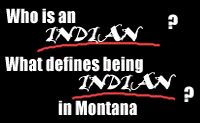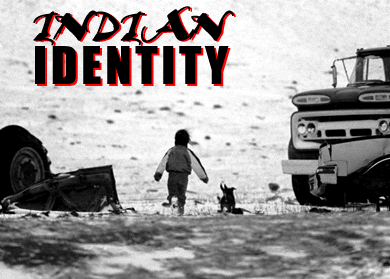
|
For most Americans the answer to the first question has always been as obvious as the reflection in a mirror.
Thirty years ago, when a Harvard anthropologist was asked to decide whether a distinct group of North Carolinians was Indian, he took along calipers and a steel tape. The answer, he decided, would lie in physical traits, in his painstaking measurement of cheekbones, lips, earlobes and noses.
For many non-Indians, that superficial assessment persists despite centuries of assimilation, centuries of living alongside America's native peoples. Stereotypes die hard. Who is an Indian? It's a matter of speech patterns, of things you can see and hear.
Or is it?
For many natives, the question runs much deeper, and it is hardly simple.
Who is an Indian?
In Montana, the answer varies from tribe to tribe, and is fraught with implications. It means entitlements, such as eligibility for health care and housing, a chance to compete for tribal money for higher education, or small cash outlays at the end of the year.
But more important, it has come to mean greater likelihood of early death, and a higher rate of illness and disease. It also means working for a higher education, then having to earn a place once back on the reservation. It can mean owning trust land, but being bound by antiquated laws that control how the land is used. for many of Montana's Indians it means enduring racism on a regular basis, or even fighting prejudices on their own reservations.
Who is Indian? Nineteen journalism students looked into the question. They hope their stories offer insights. But they learned ultimately that how a people see themselves comes mainly from inside.
 |
 |
|
|
| Owning Indian Country | Regulations once meant to protect Indians' individual land holdings are today making productive use of the land by heirs a monumental task. |
| Living With Dying | Few Native American families are untouched by tragedy. Accidents, illness and death are pervasive on the reservations. One Northern Cheyenne family cannot escape the sorrow. |
| Defining a Nation | What makes a person Blackfeet? Lineage, language and tradition, some tribal members say. If blood quantum were the only guide, one day there could be no more Indians. |
| Cheyenne Soul Searching | On the Northern Cheyenne Reservation, one religion employs peyote to help its followers look inward. Another tries to meld native traditions with Christian practices. And a new denomination hopes to change a people. |
| An Uneasy Education | Leaving the reservation for an education is a daunting prospect. And coming home with a degree is sometimes harder than leaving. |
| Pride and prejudice | Native Americans accustomed to living around friends and family confront the pain of prejudice when they leave the reservation. |
| Choosing Who Belongs | Determining enrollment in Fort Belknap's Assiniboine and Gros Ventre tribes involves scrutinizing blood quantum and family histories and meeting tribal regulations. |
 |
|
Writing and copy editors |
Carol Van Valkenburg, Matt Ochsner, Sonja Lee |
|
Photo/design editors |
Dan McComb, Ben Romans, Gordon Terpe, Adam Creagan |
|
Writers |
Tom Greene, Katie Oyan, Kim Skornogoski, Lisa Kerscher, Tom Mullen, Katja Stromnes, Paige Parker |
|
Photographers |
Lem Price, Stuart Thurlkill, Ann Williamson, Kim Eiselein, Amy Zekos, Melissa Hart, Karl Vester |
|
Web design |
Patia Stephens |
| COVER PHOTO: Janes Bullshoe, one of Leo and Molly Bullshoe's 66 grandchildren, chases after siblings while playing at the Bullshoe ranch near Heart Butte. Photo by Lem Price | Montana's Indians is a reporting project of The University of Montana School of Journalism. This is the seventh special report on issues affecting Native Americans who live in Montana. This honors class was taught by journalism professors Carol Van Valkenburg and Dan McComb. Graphics are data from the Natural Resource Information System, courtesy of the Montana State Library, Helena. |
|
|
|
|